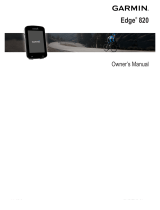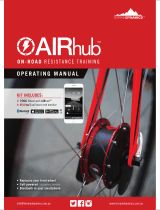
Table of Contents
Introduction.....................................................................1
Getting Started............................................................................1
Charging the Device................................................................... 1
About the Battery................................................................... 1
Installing the Standard Mount..................................................... 1
Installing the Out-Front Mount.................................................... 1
Releasing the Edge................................................................2
Turning On the Device................................................................ 2
Keys....................................................................................... 2
Viewing the Status Page................................................... 2
Using the Backlight........................................................... 2
Using the Shortcut Menu...................................................2
Acquiring Satellite Signals.......................................................... 2
Training........................................................................... 2
Going for a Ride..........................................................................2
Using Virtual Partner®................................................................ 3
Courses...................................................................................... 3
Creating a Course on Your Device........................................ 3
Following a Course From the Web........................................ 3
Tips for Training with Courses............................................... 3
Stopping a Course................................................................. 3
Displaying a Course on the Map............................................ 3
Viewing Course Details.......................................................... 3
Course Options...................................................................... 3
Deleting a Course.................................................................. 4
Segments....................................................................................4
Strava™ Segments................................................................ 4
Following a Segment From the Web......................................4
Enabling Segments................................................................ 4
Racing a Segment................................................................. 4
Viewing Segment Details....................................................... 4
Segment Options................................................................... 4
Deleting a Segment............................................................... 4
Workouts.....................................................................................4
Following a Workout From the Web.......................................4
Starting a Workout................................................................. 4
Stopping a Workout............................................................... 5
Previewing a Workout............................................................ 5
Deleting a Workout................................................................ 5
Deleting Multiple Workouts.................................................... 5
About the Training Calendar....................................................... 5
Using Garmin Connect Training Plans...................................5
Interval Workouts........................................................................ 5
Creating an Interval Workout................................................. 5
Starting an Interval Workout.................................................. 5
Using an ANT+ Indoor Trainer.................................................... 5
Setting Resistance................................................................. 5
Setting Target Power............................................................. 6
Setting a Training Target............................................................ 6
Cancelling a Training Target.................................................. 6
Personal Records....................................................................... 6
Viewing Your Personal Records............................................ 6
Reverting a Personal Record................................................. 6
Deleting All Personal Records............................................... 6
Training Zones............................................................................ 6
Training Indoors.......................................................................... 6
Navigation....................................................................... 6
Locations.................................................................................... 6
Marking Your Location........................................................... 6
Navigating to a Saved Location............................................. 6
Editing Locations....................................................................6
Deleting a Location................................................................ 6
Setting Your Elevation........................................................... 6
Zooming the Map
........................................................................ 6
ANT+ Sensors................................................................. 7
Putting On the Heart Rate Monitor............................................. 7
Recovery Advisor................................................................... 7
Turning On the Recovery Advisor..................................... 7
About VO2 Max. Estimates.................................................... 7
Getting Your VO2 Max. Estimate...................................... 7
Tips for Cycling VO2 Max. Estimates................................8
Setting Your Heart Rate Zones.............................................. 8
About Heart Rate Zones................................................... 8
Fitness Goals.................................................................... 8
Tips for Erratic Heart Rate Data.............................................8
Installing the Speed Sensor........................................................ 8
Installing the Cadence Sensor.................................................... 8
About the Speed and Cadence Sensors............................... 9
Data Averaging for Cadence or Power.................................. 9
Pairing Your ANT+ Sensors....................................................... 9
Training with Power Meters........................................................ 9
Setting Your Power Zones..................................................... 9
Calibrating Your Power Meter................................................ 9
Pedal-Based Power............................................................... 9
Cycling Dynamics.................................................................. 9
Using Cycling Dynamics................................................... 9
Updating the Vector Software Using the Edge Device........ 10
Getting Your FTP Estimate.................................................. 10
Conducting an FTP Test................................................. 10
Automatically Calculating FTP........................................ 10
Using Shimano® Di2™ Shifters............................................... 10
Using the Weight Scale............................................................ 10
History........................................................................... 10
Viewing Your Ride.................................................................... 10
Viewing Your Time in Each Training Zone.......................... 10
Deleting Rides......................................................................11
Viewing Data Totals.................................................................. 11
Deleting Data Totals............................................................ 11
Sending Your Ride to Garmin Connect.................................... 11
Garmin Connect................................................................... 11
Bluetooth® Connected Features......................................... 11
Pairing Your Smartphone................................................ 11
Transferring Files to Another Edge Device............................... 12
Data Recording......................................................................... 12
Data Management.................................................................... 12
Connecting the Device to Your Computer........................... 12
Transferring Files to Your Device........................................ 12
Deleting Files....................................................................... 12
Disconnecting the USB Cable..............................................12
Customizing Your Device............................................ 12
Profiles...................................................................................... 12
Setting Up Your User Profile................................................ 12
About Lifetime Athletes........................................................ 12
About Training Settings............................................................ 12
Updating Your Activity Profile.............................................. 13
Customizing the Data Screens............................................ 13
Changing the Satellite Setting............................................. 13
Map Settings........................................................................ 13
Changing the Map Orientation........................................ 13
Alerts.................................................................................... 13
Setting Range Alerts....................................................... 13
Setting a Recurring Alert................................................. 13
Auto Lap...............................................................................13
Marking Laps by Position................................................ 13
Marking Laps by Distance............................................... 14
Using Auto Pause................................................................ 14
Using Auto Sleep................................................................. 14
Using Auto Scroll................................................................. 14
Table of Contents i





















